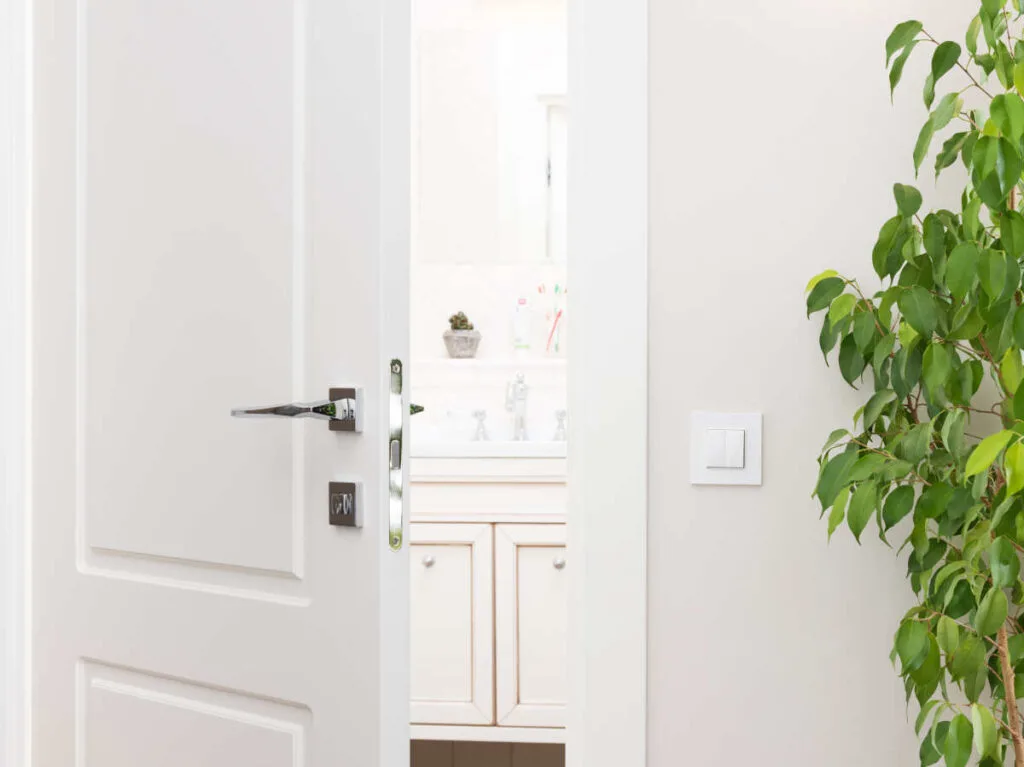Most hinged bathroom doors swing into the bathroom. But sometimes, especially in a small bathroom, it makes more sense spatially for the door to swing out. But does logic or law decide if bathroom doors should swing in or out?
A bathroom door near the top of a staircase must swing in. Otherwise, it can swing in or out. Doors that swing in don’t block hallways or hit people and are easier to leave open for moisture dissipation. Doors that swing out save space, are safer for fall-risks, and easier to force open from inside.
This article looks at when bathroom doors should swing in or out according to building regulations. It also provides some benefits of having bathroom doors that swing in and benefits of doors that swing-out. Finally, it discusses some practical considerations for the swing direction.
Are There Regulations About Which Way a Bathroom Door Should Swing

As a DIY home renovator, you know that building codes govern almost every aspect of even minor alterations. The code that you will be working with the most is the International Residential Code (IRC), which is compiled by the International Code Council (ICC).
When you first start your DIY remodeling career, the IRC regulations and rules can sneak up on you and cause a lot of hassle. But after a while, you learn to check the code before doing anything. In other words, you start asking questions like “should bathroom doors swing in or out?”
So, is there a clause in the IRC that says whether your bathroom doors should swing in or out? Well, you will be pleased to find out that there is no clause dictating which direction your bathroom door should swing.
However, there is a statement in chapter three, section R311.7.6 Landings for Stairways, that says the following:
A floor or landing is not required at the top of an interior flight of stairs, including stairs in an enclosed garage, provided that a door does not swing over the stairs.
IRC R311.7.6
This means that if your bathroom is situated adjacent to the top of a staircase, the door must swing in so that it can never block the top of the staircase or knock someone down the stairs when it is opened.
Benefits of a Bathroom Door That Swings In
- If your bathroom is off of a hallway, then a door that swings in will ensure that the hallway is never blocked.
- If a bathroom door swings out, you can easily hit someone who is walking past. This is not a problem with a door that swings in.
- If a bathroom door swings in, you are more likely to leave it open when it’s not in use because it will not get in the way. As you can see from this article on the hazards associated with keeping a bathroom door closed, this is really important to your health.
- If you have small children, then a bathroom door that swings in is a better choice. Children can get locked inside the bathroom, and you will have to break in to get them out; this is easier to do if the door swings in.
- A bathroom door that swings in is better at controlling odors because opening a door inward also causes an inward flow of air, helping to keep any odors inside the bathroom. A door that swings out would have the opposite effect.
- A bathroom door that swings in is better for privacy in two ways. First, if you forget to lock the bathroom door and someone else tries to enter, it is easier to push the door closed than it is to try to grab the handle and pull it shut. Second, a door that swings in covers the bathroom’s interior while the door is opening, meaning that less is seen before the door is shut again.
Benefits of a Bathroom Door That Swings Out
- If your bathroom door swings out, it allows you to utilize the entire floor space of the bathroom, which is a significant benefit in small bathrooms.
- If someone in the bathroom falls in front of the door, you can still get inside to help them if the door swings out. This is especially important for the elderly, and it is a common aging-in-place home modification.
- If you get stuck in a bathroom and you have to force your way out, then it is much easier to do so if the door swings out. This is a particularly important consideration if you live alone.
- If you have lots of people using the same bathroom, you cannot guarantee that each person’s hygiene standards are up to scratch. A bathroom door that swings out is easier to open without using your hands (unless it has a round doorknob—then it’s just as difficult).
- Bathroom doors that swing out will not create “hazardous locations” for glazing and mirrors.
- You save space in a small bathroom that has an outward swinging shower door.
Practical Considerations for the Swing Direction of a Bathroom Door
Now you know that there are no official regulations regarding the swing direction of bathroom doors, and you know the benefits of doors that swing in and doors that swing out.
However, before you decide which direction you want your bathroom door to swing, there are a few other factors that you also need to consider.
Bathroom Doors Should Not Interfere With Other Doors
Bathroom doors that swing in should not interfere with the opening path of any other doors in the bathroom. This includes the shower door, the vanity door, or even a second entry door (some bathrooms open onto a hallway and a bedroom or two different bedrooms). If the bathroom door opens onto any other door, it increases the risk of damage to both.
If opening your bathroom door significantly interferes with using the bathroom, then you most likely have a space issue, and a door that swings out might be your best option. In the case of a bathroom with two doors, you might want one to swing out and one to swing in.
Bathroom doors that swing out should not swing out over another doorway.
Bathroom Doors Should Not Open Against Windows
Whether a bathroom door swings out or in, you do not want it to open against a window. You also have to consider glass shower doors and walls for inward-swinging doors. Repeated contact between a metal door handle and glass panes increases the chance of the glass breaking.
Practical Considerations Specifically for Bathroom Doors That Swing Out Into Hallways
A bathroom door that swings out into a hallway will need to be on hinges that allow it to be opened flush against the wall. Without this design adaptation, someone can easily bang their shoulders, stub their toes, etc., on the door.
Another design requirement for bathroom doors that open out into hallways is a handle that sits as flat against the door as possible (amazon link) while still remaining functional.
A protruding door handle can cause injury if someone bumps into it, but there is also the risk of catching and tearing clothes on the door handle.
These two considerations are especially important if you have children or animals that race up and down the hallway. They are less important if your bathroom is at the end of a hallway.
Can You Change the Direction That a Bathroom Door Swings?

Suppose you have a bathroom door that swings in, but you want to install a bigger bathtub, shower, or vanity, which would interfere with opening the door. Or perhaps you have a bathroom door that swings out, and you’ve kicked your little toe on it one too many times.
Whatever your reason for wanting to change the direction that your bathroom door swings, it is definitely possible for a capable home renovator like yourself!
There are two options for changing the swing direction of your bathroom door:
- Reverse the existing door within the frame. This involves moving the hinges and locks on the door, moving the latch hole and door stops in the frame, and patching up the previous holes and hinge mortices.
- Reverse the whole frame. This video demonstrates how to reverse the entire door frame and door within the wall.

